Snoring, Sleep Apnea & Mouth Breathing: How Myofunctional Therapy Can Help (Ottawa, 2025)
“Myofunctional therapy trains muscles in your mouth and face to move in ways that support eating, breathing, swallowing and more. Therapy may help with conditions like obstructive sleep apnea and TMJ disorders.”
— The Cleveland Clinic
Audience: Adults with sleep apnea / snoring, parents seeking non-invasive solutions for their child, dentists, sleep specialists
Read time: 5 minutes
Key takeaway: "Targeted tongue and airway exercises significantly improve airway stability, reduce apnea events, and complement other sleep therapies without surgery or medication." Mayo Clinic
Why Sleep-Disordered Breathing Matters
Fact
1 in 5 adults has mild-to-moderate sleep apnea; many remain undiagnosed.
Snoring and apnea disrupt sleep quality, causing fatigue, cognitive issues, and long-term health concerns.
50% of sleep apnea patients struggle with CPAP compliance.
What It Means
Fatigue, mood swings, and health risks go unnoticed or untreated.
Poor sleep isn’t just noisy—it’s harmful.
Alternatives like myofunctional therapy become crucial for sustained health improvements.
Signs You Could Benefit from Orofacial Myofunctional Therapy for Sleep

Frequent Snoring or Noisy Breathing at Night
Snoring isn’t just a nuisance—it’s a sign that your airway might be partially blocked.

Daytime Fatigue, Brain Fog, or Trouble Concentrating
Waking up tired—even after 7 or more hours—can point to disrupted or poor-quality sleep.
Difficulty Adjusting to CPAP or APAP Therapy
If you struggle with pressure settings, dry mouth, or discomfort from your sleep machine.
Waking Frequently or Gasping During the Night
These sneakers are designed to outlast many summers with their high-quality construction.
How Myofunctional Therapy Improves Sleep
Dynamic Airway Toning & Nasal Breathing
Orofacial Myofunctional Therapy strengthens the muscles that support your airway and retrains you to breathe through your nose—naturally increasing oxygen intake and improving nighttime airflow.
Targeted Muscle Training
Exercises focus on the tongue, soft palate, and jaw muscles, helping to prevent airway collapse during sleep and supporting more stable, uninterrupted breathing.
Nasal Breathing with Lip Toning
By combining nasal breathing with improved lip seal, OMT reduces mouth breathing, snoring, and dry mouth, all of which contribute to deeper, more restorative sleep.
Support for CPAP/APAP Users
Orofacial Myofunctional Therapy can make CPAP or APAP therapy more effective and comfortable by reducing required pressure settings—leading to better compliance, fewer side effects, and long-term sleep improvement.
Beyond the Basics: 5 OMT Exercises for Better Sleep & Airway Health
| Exercise | What It Trains | Why Your Airway Benefits |
|---|---|---|
| “Tongue-to-Spot” Suction Hold | Tongue-palate seal, tongue muscle control | Maintains airway openness, reduces snoring |
| Soft Palate Elevation (“K” Sounds) | Soft palate strength, throat muscle tone | Reduces tissue collapse, fewer apnea episodes |
| Lip Taping Practice | Lip closure, nasal breathing habit | Enhances nasal airflow, reduces mouth breathing |
| Diaphragmatic Breathing | Respiratory muscle strength and coordination | Improves oxygen intake, stabilizes breathing patterns |
| Cheek Puff Exercise | Oral muscle tone, upper airway stability | Minimizes airway narrowing during sleep |
These exercises are only a glimpse of the full Oral-Facial Advantage program; with guided coaching and steady practice, you can achieve substantial, measurable improvements.
Sources:
Cleveland Clinic. "What Is Myofunctional Therapy?"
Camacho M, et al. "Myofunctional Therapy to Treat Obstructive Sleep Apnea: A Systematic Review and Meta-analysis." Sleep, 2023.
Mayo Clinic. "Sleep apnea - Diagnosis and treatment."
Risks of Leaving Sleep-Disordered Breathing Untreated
- Increased cardiovascular risk
- Chronic fatigue and cognitive decline
- Elevated blood pressure and stroke risk
- Higher risk of diabetes and obesity
- Impaired immune function and mood disorders
The Process of Orofacial Myofunctional Therapy
We perform a 360º OMT 2 hour assessment at our Ottawa clinic to pinpoint each patient’s unique mix of factors.
Initial Assessment
A detailed consultation to evaluate airway function, oral posture, and breathing patterns.
Customized Exercise Plan
A simple, daily set of exercises designed specifically for your sleep-breathing needs.
Regular Progress Reviews
Brief check-ins to monitor improvement, adjust exercises, and ensure effectiveness.
Collaboration with Healthcare Providers
Regular communication with your sleep physician, dentist, or ENT to coordinate your overall care plan.
(Full exercises and instructions are provided individually and tailored specifically to your condition.)
Frequently Asked Questions
Q: Can OMT completely replace CPAP?
A: For mild to moderate apnea, OMT may significantly reduce symptoms. Severe cases often benefit from a combined approach, reducing CPAP pressures and improving comfort.
Q: Is myofunctional therapy painful or difficult?
A: No. Exercises are gentle, easy to learn, and designed for comfort and convenience.
Q: Is myofunctional therapy a bandaid superficial approach?
A: No, myofunctional therapy addresses the root causes of orofacial muscle dysfunction, making it a foundational and lasting solution—not a superficial fix.
Case Snapshot — “Jamie,” 42, Ottawa
| At Intake | During Therapy | After Therapy |
|---|---|---|
| Loud nightly snoring, waking tired with headaches, difficulty with CPAP mask | Snoring noticeably quieter, fewer headaches, improved energy levels | Significantly reduced snoring, most nights no snoring, better CPAP tolerance, waking refreshed and energetic, increased memory capacity |
A consistent Orofacial Myofunctional Therapy routine can make a noticeable difference in sleep quality and daytime vitality, as "Jamie" experienced.



